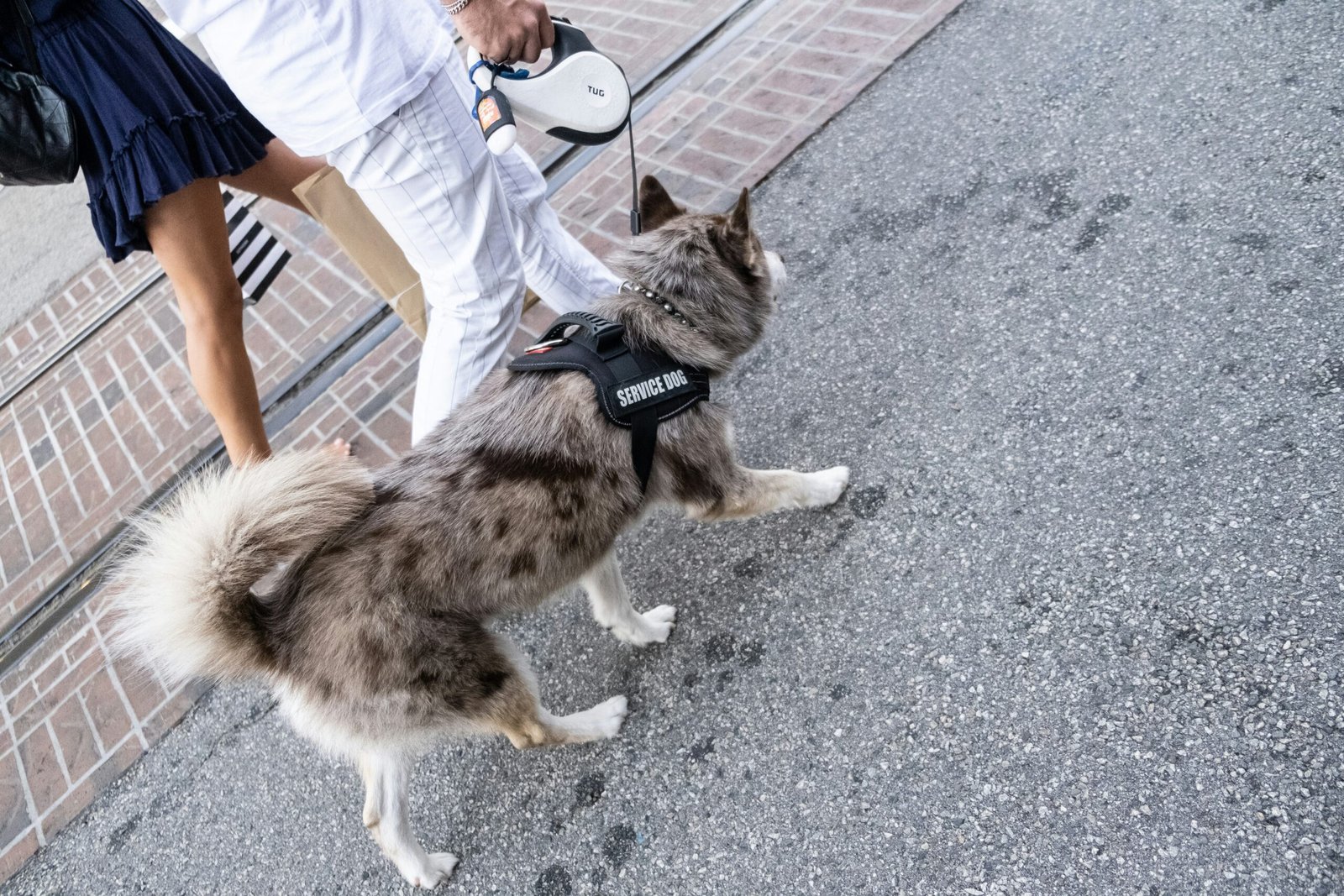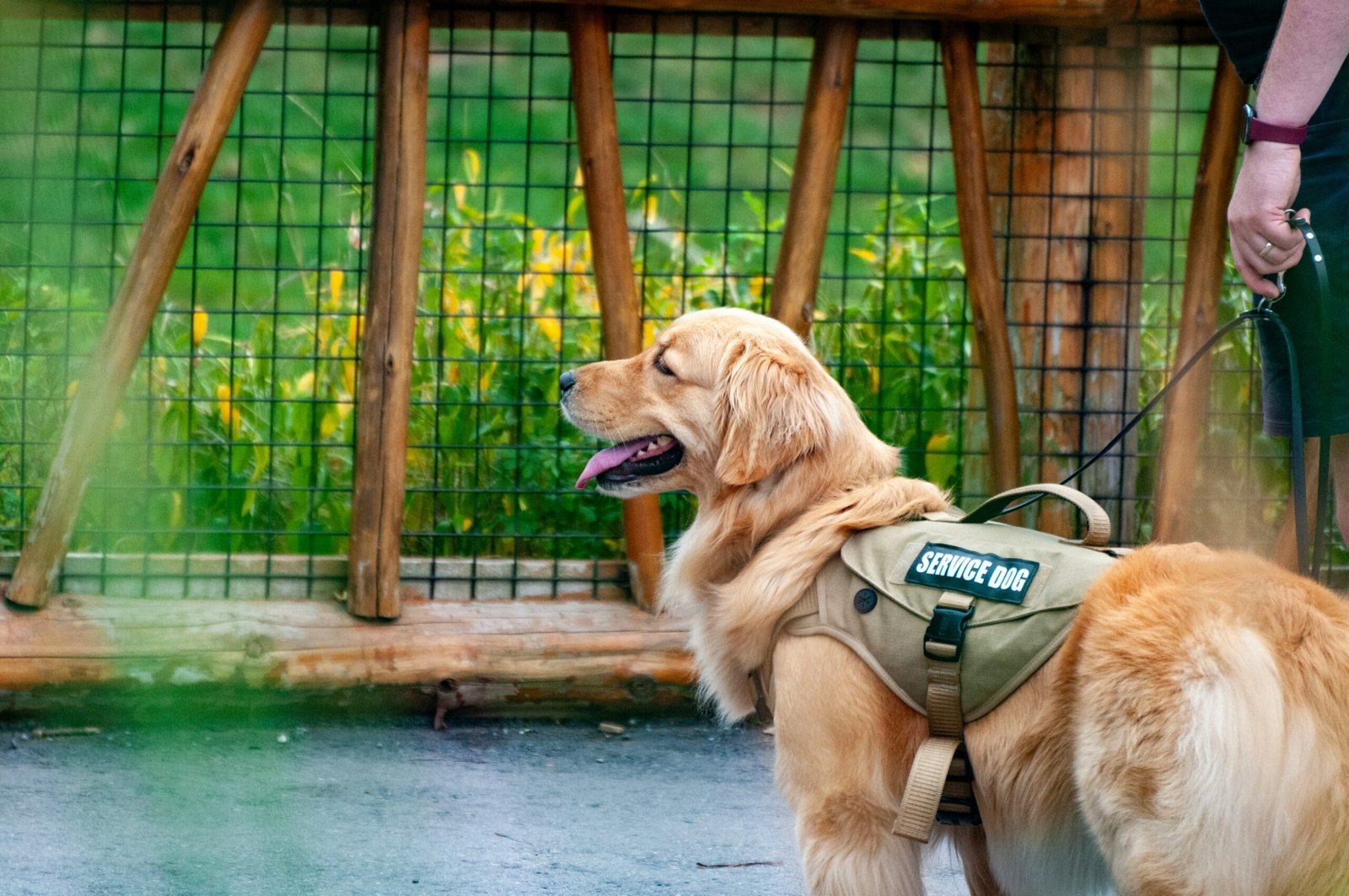Introduction to Service Dog Training
How To Train Your Dog To Be a Service Dog: A service dog is specially trained to perform tasks that assist individuals with disabilities, enhancing their ability to navigate daily life. These dogs provide crucial support in various capacities, showcasing the remarkable bond between humans and animals. Service dogs encompass a diverse array of roles, each tailored to meet specific needs.
Guide dogs are perhaps the most well-known type of service dog, offering vital assistance to individuals who are blind or visually impaired. They help navigate obstacles and ensure the safety of their handlers in a bustling world. Similarly, hearing dogs aid those who are deaf or hard of hearing by alerting them to important sounds like doorbells, alarms, or the cry of a child.
Mobility assistance dogs are trained to support individuals with physical disabilities. They can perform a range of tasks, such as retrieving dropped items, opening doors, or even helping with balance and stability while walking. These tasks significantly improve the autonomy and quality of life for their handlers.
Medical alert dogs are another essential category, trained to detect and respond to various medical conditions. These dogs can sense the onset of seizures, drops in blood sugar levels for diabetics, or even impending migraines. Their ability to alert their handler to these conditions allows for timely intervention and management of potentially life-threatening situations.
The Americans with Disabilities Act (ADA) provides the legal framework recognizing and protecting the rights of individuals who rely on service dogs. Under the ADA, a service dog must be individually trained to do work or perform tasks directly related to the person’s disability. This law ensures that service dogs are allowed to accompany their handlers in most public places, from restaurants and stores to public transportation and workplaces.
Understanding the importance and scope of service dogs underlines the complexities involved in training them. The journey of learning how to train your dog to be a service dog involves dedication, patience, and an understanding of the specific requirements each role entails.
How To Train Your Dog To Be a Service Dog: Assessing Your Dog’s Suitability for Service Dog Training

The journey to training your dog to be a service dog begins with assessing your dog’s suitability for such a demanding role. Not every dog is predisposed to becoming a service dog, making the initial evaluation a critical step. This assessment includes a multifaceted examination of traits like temperament, age, breed, and overall health.
To start, the ideal age for a dog to begin training is usually between one and three years old. Dogs older than this may still be trainable, but the window where they are most receptive to learning new skills and commands is generally during these formative years. Breed considerations also play a significant role; while service dogs come in all shapes and sizes, specific breeds are known for excelling in this domain due to their natural predisposition for intelligence, obedience, and work ethic. Breeds such as Labrador Retrievers, Golden Retrievers, and German Shepherds are often highlighted for their exceptional service capabilities.
The physical and mental health of your dog is another crucial aspect in determining suitability. Preliminary health assessments should include a comprehensive veterinary check-up to rule out any conditions that might impede your dog’s ability to perform service-related tasks. Regular health checks will ensure that your dog is in prime condition to undergo rigorous training.
Behavioral traits carry equal importance. Fundamental traits like obedience and calmness are non-negotiable for any prospective service dog. These dogs must respond consistently to commands and remain composed even in high-stress situations. Socialization skills are also imperative; a potential service dog should be comfortable around various people, other animals, and different environments without displaying aggression, fear, or excessive distraction.
Assessing these key factors provides a solid foundation for embarking on the journey of training your dog to be a service dog. By ensuring your dog exhibits the right traits and meets health criteria, you set the stage for a successful and rewarding training experience.
How To Train Your Dog To Be a Service Dog: Basic Training Foundations
A fundamental step in preparing your dog for service work is ensuring a strong foundation in basic commands. Mastering commands like ‘sit,’ ‘stay,’ ‘come,’ ‘heel,’ and ‘leave it’ are crucial before advancing to specific service dog training. These basic commands establish control, build trust, and enhance communication between you and your dog, setting the stage for more specialized training tasks later on.
The command ‘sit’ serves as an invaluable tool for managing your dog’s behavior in various situations. It promotes calmness and focus, both essential traits for a service dog. ‘Stay’ is another vital command, teaching your dog to remain in place and control impulses, an ability that greatly enhances safety in public settings. ‘Come’ is essential for ensuring your dog reliably returns to you, which is particularly important for a service dog needing to respond promptly to the handler’s call.
The ‘heel’ command ensures your dog walks closely beside you, which is paramount for maintaining proximity and assisting with physical stability if required. ‘Leave it’ instructs your dog to ignore distractions or hazardous items, a crucial skill for navigating complex environments.
Achieving mastery in these commands relies heavily on consistency and patience. Dogs thrive on routine and clear expectations, so it’s essential to use the same commands and signals every time, rewarding correct behaviors promptly. Positive reinforcement, such as treats, toys, or praise, motivates your dog and strengthens desirable behavior patterns.
Clicker training can be particularly effective in the foundational phase. The clicker serves as a precise marker of the exact moment your dog performs a desired action, bridging the gap between the behavior and the reward. This method enhances clarity, accelerates learning, and makes the training process enjoyable for your dog.
Building a strong foundation of basic training commands sets the stage for more advanced service dog tasks. Ensuring your dog responds reliably to ‘sit,’ ‘stay,’ ‘come,’ ‘heel,’ and ‘leave it’ will greatly facilitate their overall service dog training journey. By fostering a training environment rooted in consistency, patience, and positive reinforcement, you create a framework for your dog to succeed as a reliable and well-behaved service companion.
Advanced Training Techniques
Successfully training your dog to be a service dog involves meticulous attention to advanced training skills. These skills are essential for the dog to perform specific tasks relevant to the handler’s needs. For instance, one crucial advanced skill includes the ability to retrieve objects on command. This task, often necessary for individuals with mobility issues, requires the service dog to accurately identify and bring the requested item to the handler. The dog must be taught not only to understand the command but also to carry out the task with precision and reliability, ensuring the object is delivered safely without damage.
Another vital component of advanced training is teaching the dog to open doors. This can be particularly beneficial for individuals who may struggle with door handles or require assistance entering different rooms. This task involves training the dog to understand various door mechanisms, from traditional handles to push-button doors, ensuring they can provide consistent support in diverse environments.
For those needing physical assistance, balance support is another critical advanced skill. This requires the dog to be trained to move in sync with the handler, providing steady support while walking, standing up, or sitting down. The dog must maintain a calm and measured demeanor, offering reliable assistance without being a source of additional instability.
Moreover, training a dog to alert to medical conditions is a pinnacle of advanced service dog training. This could mean teaching the dog to recognize changes in their handler’s body chemistry indicative of an oncoming seizure, dangerous blood sugar levels, or other medical crises. Such training involves consistent conditioning and requires the dog to react swiftly and accurately, potentially signaling the handler, fetching medication, or alerting another person.
The importance of precision and reliability in these advanced tasks cannot be overstated. A service dog must consistently perform their role with impeccable accuracy to genuinely support their handler’s independence and well-being. By focusing on these advanced training techniques, handlers and trainers ensure that service dogs can provide indispensable assistance tailored to individual needs.
How To Train Your Dog To Be a Service Dog: Public Access Training
Training a dog to be a service dog involves rigorous public access training to ensure the dog behaves appropriately in various public settings. This aspect of training is critical, as service dogs must remain calm, focused, and well-mannered regardless of the environment or distractions they encounter.
To begin public access training, expose your dog to different environments such as busy streets, shopping centers, public transportation, and parks. Gradual exposure helps the dog acclimate to various stimuli, including loud noises, crowds, and unfamiliar smells. Start with less crowded areas and progressively move to busier locations as your dog’s confidence and composure improve.
Introducing your dog to various types of people is equally important. Ensure they remain composed around children, adults, people using mobility aids, and those exhibiting different behaviors. Teaching your dog to ignore distractions, such as people trying to pet them or other animals, is crucial for maintaining their focus on assisting you.
Real-world scenarios provide excellent training opportunities. For instance, while in a restaurant, your service dog should be able to sit quietly under the table without begging for food or getting distracted by the commotion. In a grocery store, they need to navigate aisles calmly and ignore tempting food displays or other customers. During a ride on public transportation, your dog should stay close to you, not become anxious, and remain unobtrusive to other passengers.
Positive reinforcement techniques, such as treats, praise, and toys, are effective in reinforcing desired behaviors during public access training. However, consistency and patience are key. Regularly practicing and gradually increasing the complexity of situations your dog is exposed to can build the foundation for reliable behavior in diverse public environments.
By comprehensively addressing public access training, you’ll be well on your way to learning how to train your dog to be a service dog capable of handling various real-world scenarios with confidence and composure.
Building Bond and Communication
Training a dog to be a service dog begins with foundational principles grounded in bond and communication. Establishing a strong relationship between handler and service dog is essential. This foundation of trust and mutual understanding forms the cornerstone of effective service dog training and functionality. Regular practice sessions are key to fostering this bond, reinforcing positive behaviors through consistent routines and clear expectations.
Communication is at the heart of this relationship. Utilizing both visual and verbal cues can significantly enhance the dog’s comprehension and responsiveness. Hand signals paired with specific commands can provide clarity and reduce ambiguity, ensuring that the dog accurately understands the handler’s needs. Consistency in these cues is critical; fluctuating signals or commands may lead to confusion and impede the training progress.
Emotional support also plays a vital role in the training process. Dogs, like humans, thrive on emotional connections. Providing positive reinforcement through praise and treats when the dog performs desired tasks not only boosts morale but also strengthens the bond. Additionally, gentle physical interactions such as petting or play can enhance emotional connectivity, making the service dog more attuned to the handler’s emotional states and needs.
Mutual understanding between the handler and dog is the linchpin of successful service dog teams. This relationship is built on respect and trust. The dog must trust the handler’s guidance and decisions, while the handler must also trust the dog’s abilities and responses. This dynamic interchange ensures that the dog remains focused, responsive, and reliable in various situations, ultimately facilitating a more seamless and effective partnership.
By dedicating time and attention to building a strong bond and effective communication, handlers can lay a robust foundation for advanced training — making the journey of how to train your dog to be a service dog both rewarding and successful.
Certification and Legal Requirements
When considering how to train your dog to be a service dog, understanding the certification and legal requirements is essential. Certification isn’t mandated by federal law in the United States, but having your dog pass a recognized service dog certification test can be beneficial. Various organizations offer certification, each with specific tests that assess a dog’s ability to perform service tasks reliably. Reputable certifications often include comprehensive evaluations of obedience, public access behavior, and specific service tasks to ensure the dog can perform its duties under various circumstances.
Organizations such as the American Kennel Club (AKC), Assistance Dogs International (ADI), and the International Association of Assistance Dog Partners (IAADP) offer certification programs. These programs include tests like the Public Access Test, which evaluates the dog’s behavior in public settings, and task-specific assessments to demonstrate the dog’s proficiency in aiding the handler. To be eligible for certification, handlers typically need to provide detailed documentation, including proof of the handler’s disability and evidence of the dog’s training history and vaccinations.
Legal Rights and Responsibilities
Laws such as the Americans with Disabilities Act (ADA) govern the rights and responsibilities of service dog handlers. Under the ADA, individuals with disabilities who utilize service dogs have the right to access public places, including restaurants, stores, and hospitals. Service dogs must be permitted even in areas where pets are traditionally prohibited. However, service dogs must be well-behaved and under control at all times; disruptive or aggressive behavior can be grounds for exclusion.
Handlers are also responsible for their service dogs’ conduct in public. This includes ensuring the dog is clean, well-groomed, and appropriately equipped with identifying vests or tags, even though the ADA doesn’t require them. Handlers should educate themselves on the legal landscape to advocate effectively for their rights and those of their service dogs.
Maintenance and Continuing Education
Ensuring your dog remains a proficient service animal involves thorough maintenance and continuing education throughout their working life. Consistent reinforcement of the skills learned during initial training is essential. Regular training routines are crucial to keep these skills sharp and responsive. Allocating time each day for training sessions, even if brief, can help maintain the dog’s ability to perform its specific tasks reliably.
Regular health check-ups are also a fundamental aspect of maintaining a service dog’s performance. Scheduled visits to the veterinarian will help monitor your dog’s physical well-being, ensuring they are fit to perform their duties. Discuss with your vet about the appropriate diet, exercise, and preventive care measures suitable for an active service dog. Keeping the dog physically healthy will directly impact their capacity to serve effectively.
Mental stimulation is equally important in the upkeep of a service dog. Engage in activities that challenge their problem-solving abilities and keep their minds active. Incorporate puzzle toys, varied environments, and command variations into their routine. This not only keeps the dog mentally agile but also fosters a deeper bond between you and your service dog.
Ongoing assessment is imperative to evaluate the dog’s continued effectiveness as a service partner. Periodically review their performance in real-world situations, adjusting training techniques to address any observed weaknesses. Professional trainers can offer valuable insights and provide advanced training sessions tailored to the evolving needs of the service dog.
Incorporating these practices ensures your service dog remains a reliable and efficient aid. The commitment to maintaining their skills, health, and mental engagement is a continuous process that extends far beyond initial training. By doing so, you assure that your service dog can consistently meet the demands of their role, enhancing the quality of life for both the dog and its handler.
If you need a website for your business, blog, or e-commerce store, just click the link here





